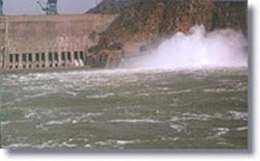
SANMENXIA DAM AND RESERVOIR PROJECT
1. GENERAL DESCRIPTION
Sanmenxia Dam and Reservoir Project built in 1957 is
located in Sanmenxia City, Henan Province, being the first large dam project for flood
control, imigation, power generation, water supply and other purposes since the founding
of the People's Republic of China, and also the first of this type on the Yellow River.
There is a catchment area of 688,000 km2 above the damsite, sharing 91% of the
total of the whole valley, controlling 89% of the total water vield and 98% of the total
sediment vield of the Yellow River.Due to the controversal normal pool level and operation
mode before the project construction, and the changed sedimentation and operation mode
after the project operation, the reservoir storage capacity and operation mode
considerably differ from as previous designed. There is presently a check flood level of
324 m (Dagu elevation, the same below), design flood level of 335 m, ice control level of
326 m, spring irrigation level of 324 m, and flood-season limiting level of 305 m.
As a conservancy project assisted by the Leningrad Branch of the former USSR, it was designed by the Water Power Designing Institute, Ministry of Power Station, USSR, and constructed by Sanmenxia Construction Bureau. Underestimation of the sediment problem caused a lot of problems when the reservoir was put into operation in 1960, such as serious sedimentation, quick loss of storage capacity, upward extension ofsedimentation in the Wei River, a tributary in the reach,and blockage of flood discharge, Which endangered the Wei River flood control and the safety of Xi'an City. Through continuous summarization of experience, the operation mode was changed from "storing water and retaining sediment" to "detaining flood and discharging sediment" and finally "storing clear water and discharging muddy flow for water and sedimnet regulation". As a result, the project had to be rebuilt twice.
The first reconstruction (1965-1968) included the
provision of two additional flood/sediment tunnels in the left rock mass and conversion of
4 power penstocks to flood/sediment penstocks. The second reconstruction was implemented
in 2 stages: Stage 1(l969-1979) mainly include reopening of diversion outlets 1#-8#,excavation
of power penstock intakes 1#-5#,and installation of 5〜50MW generator units, whilst Stage 2 (1984-today) involved
conversion of bottom outlets 1#-8#, reopening and conversion of
bottom outlets 9#-12#.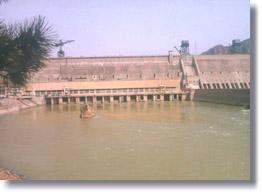
Reconstruction of the reservoir has greatly enlarged the flood/sediment discharge capacity, achieved basic balance of reservoir scouring/silting, and made it ready for giving full swing to multipurpose operation.
Construction of the project, as a significant step toward the, Yellow River regulation and management development, has experienced an unprecedented difficulties and zigzags in the course of water project construction. The great achievements in the project constnlction operation have not only produced enomlous benefits in mitigating/offsetting noods and making overall use of the water resources in the Yellow River, but also provided rich experience and lessons, which has profoundly influenced the Yellow River management strategy and planning, sediment science, as well as construction and management, which has made great contributions to the course of water conservancy and hydropower construction in China.
2. STRUCTURES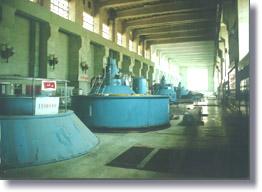
The main dam is of a concrete gravity type, with a
length of 713.2 m, maximum height of 106 m, including 111.2 m left non-overflow section
and 124 overflow section, 23 m dividing pier, 232 m powerhouse section, and 223 m right
non-overflow section. The auxiliary dam on the right bank is of a double-hinge core
(concrete core) sloping groin type with a length of 144 m.Flood discharge structures
include 12 deep outlets and 12 bottom outlets (converted from construction diversion
bottom outlets) arranged in the overnow section, 2 flood/sediment tunnels in the left rock
mass and 1 flood/sediment penstock in the powerhouse. section, thereby providing a flood
discharge capacity of 14,350 m3/s at the water level below E1 335 m. The 12
deep intakes are all arranged at the bottom elevation of E1 300 m, whilst the bottom
outlets are at E1 280 m, both have 3m〜8m rectangular
sections. The bottom elevation of both tunnel intakes are set at E1 290 m, of which
pressure sections are circular with a diameter of 11m. The penstock (8#) is
converted from the previous unit 8# penstock, with an intake bottom elevation
of E1 300 m and a diameter of 7.5 m.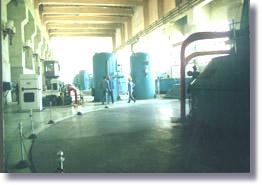
The dam-toe powerhouse has a total length of 233.9 m, width of 26.2 m, height of 22.5 m, and total installed capacity of 1,160 MW (8〜145MW) as previously designed. As a result of the project reconstruction, there are now 7 units, of which units 1#-5# have ZZ010-LJ-600 movable propellers with a separate rated output of 51.6 MW, designed head of 30 m, maximum head of 52m and minimum head of 15m, and TS-990/120-60 generators with a capacity of 62,500 kVA and power of 50 MW; units 6#-7# have HL820-LJ-550 Francis turbines with a maximum head of 47.7 m, minimum head of 27.4 m and design head of 36 m, and SF75-68/1350 generators with a rated capacity of 75 kW. The annual output is 1 GWh.
Main work quantities of the project (including reconstruction) are as follows:
earth works: 14.998 million m3 (including 1.951 million m3 main works)
rock works: 3.631 million m3 (including 1.54 million m3 main works)
concrete works: 2.1454 million m3 (including 1.901 million m3 main works)
foundation grouting: 6,670 m joint grouting: 140,000 m metal worlcs: 23,574.2t
3. COMPREHENSIVE BENEFITS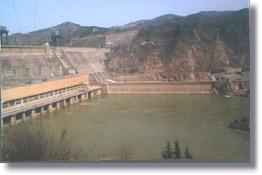
Sanmenxia Dam and Reservoir Project, when completed, have not achieved the objectives as previously designed, but have produced enormous comprehensive benefits through reconstruction at two different times.
3.1 Flood Control
The project controls the major sources of floods from the middle mainstream of the Yellow River including its tributaries such as the Wei,Jing and Beiluo rivers, provides peak flow staggering and regulation for Sanmenxia-Huayuankou section during floods, relaxes the downstream flood protection and emergency relief responsibilities, and mitigates flood calamities in the downstream area. Since 1964, the areas above Sanmenxia have occurred 6 major floods larger than 10,000 m3/s. With peak flow curtailment enabled by the project in a timely manner, the downstream dike responsibilities and inundation losses have been considerably reduced.
3.2 Ice Prevention
Ice run is unique to the Yellow River. It means a situation that the lower reach freezes from downstream to upstream in winter but thaws from upstream to downstream as temperatnre decreases and latitude increases from upstream to downstream, thus drift ice often blocks local river sections, causes icejams or icedams, and eventually raises water levels, submerges floodplain areas and even leads to dike breaches. When the project is being put into operation, flow regulation has avoided 6 dangerous omens similar to the breaches occurring in the estuary in 1951 and 1955.
3.3 Irrigation and Water Supply
With water stored during the ice run and spring flood season, the project makes 1.4 billion m3 water available for spring irrigation use in the downstream area each year. During the period of 1973 to 1998, an additional volume of 30 billion m3 water and an accumulative storage of 35 billtion m3 relaxed the tight water supply for irrigation use of 2.67 million ha farmland and for industrial/municipal use of Zhengzhou, Kaifeng, Xinxiang,Puyang, Jinan, Binzhou and Dongying cities, as well as Shengli and Zhongyuan oil fields.
3.4 Power Generations Sediment Reduction and
Environment Protection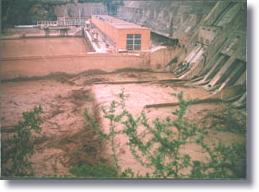
With the first unit put into commission in 1973, the fifth unit installed in 1978 and 2 additional ones provided in 1994 and 1997 respectively, the total installed capacity reaches 400 MW. By the end of 1998, a total output of 24.8 GWh has been produced. Also, the power station is responsible for peak/frequency/phase regulation and emergency stand-by power supply for Henan power grid. The operation mode "storing clear water and discharging muddy flow" has enabled water and sediment to match each other, which facilitates sediment discharge into the sea and achieves 60-80 million t sediment reduction in the lower river channel. An additional now of 300 m3/s to the lower reach in the low-now season ensures water supply for the downstream cities and allows environmental improvement. Especially, with unitary dispatch of water yields exercised in the entirety of the river in 1999, now regulation by the reservoir has mitigated the situation of now disruption in the lower reach and produced significant social and economic benefits.
On the other hand, lots of findings have been obtained since the project operation, which renders great contribution to water conservancy and hydropower technological advancement as well as hydro project construction. A reservoir operation mode of "storing clear water and discharging muddy flow" has been developed, which provides rich experience for the operation mode of large multipurpose dam projects(e.g. Sanmenxia, Xiaolangdi) on silt-laden rivers. The, successful operation of double-layer-outlet (deep and bottom) hydrulic structures has produced profound influence to hydraulic design theories and practices. Long-time practice over the years has succeeded in solving the problem of cavitation damage and sediment abrasion in silt-laden rivers. Development and application of unit wear materials have basically solved the difficutt problem of turbine blade cavitation, and initially realized power generation with muddy water. Application of "special deep steel cofferdam"' to the project reconstnlction has successfully settled the difficulty of underway construction operations without interference to the normal operation of reservoirs and power plants. The project construction, operation and management have trained a large number of technical and managerial specialists in the field of water conservancy, whose footprints can be found at Sanmenxia, Xiaolangdi, Wanjiazhai, Liujiaxia, Gezhouba and Danjiangkou multipurpose dam projects and etc. These specialists have made great contributions to the growth of water conservancy and hydropower undertakings in China. Sanmenxia is considered as the cradle of high dam construction in China.
|
|